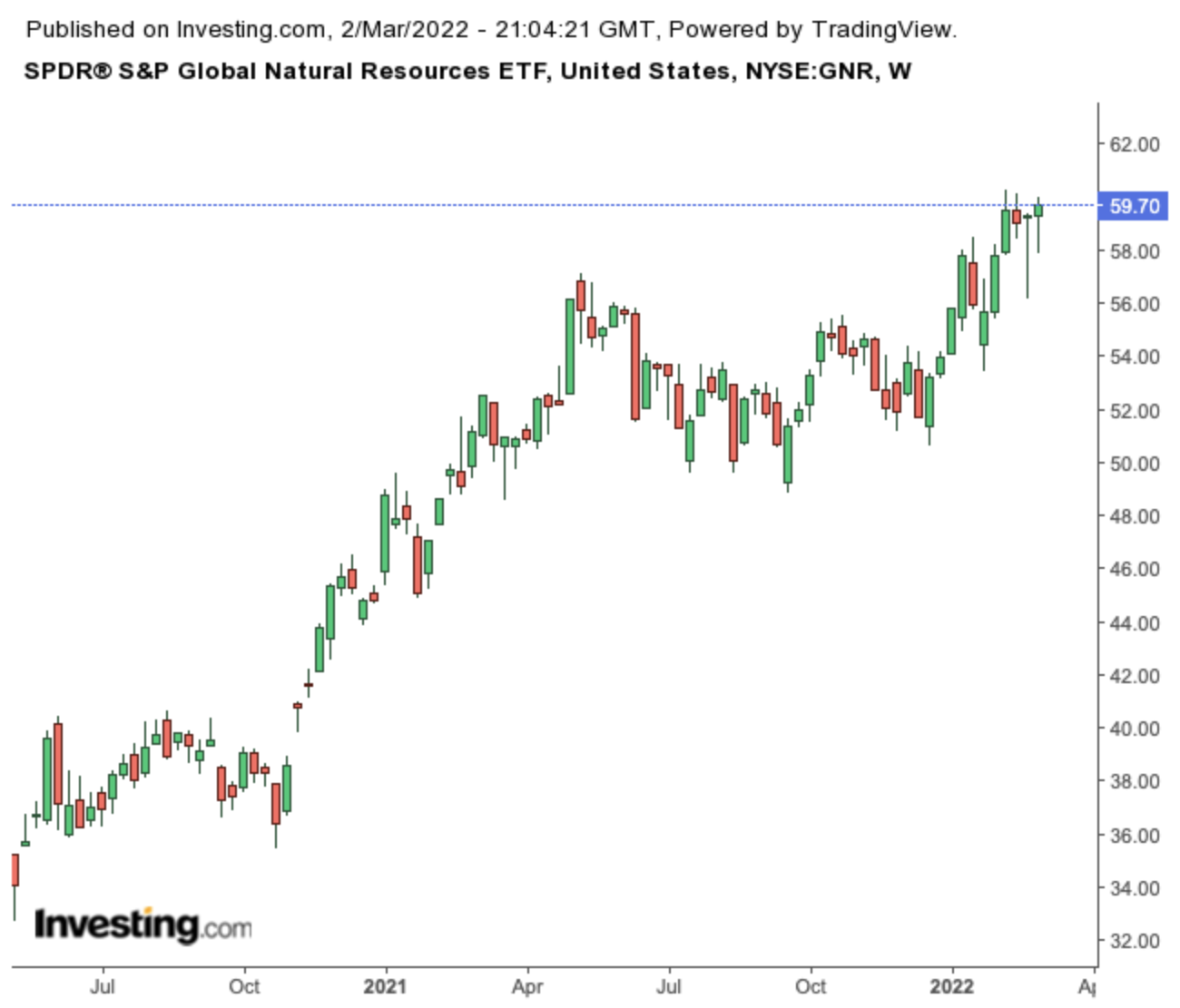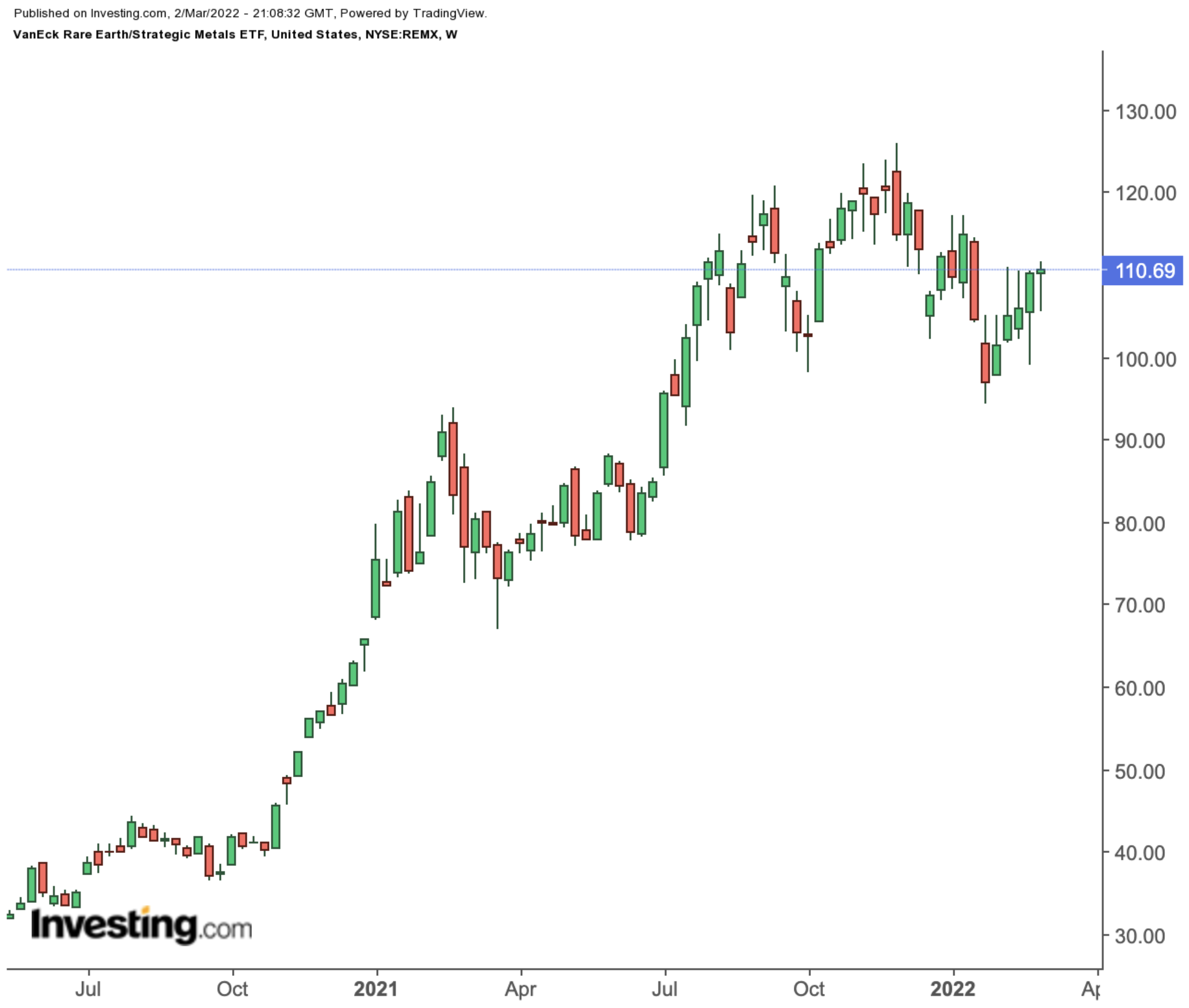After spending years in a slump, commodity prices have been on a steady uptrend for more than a year now. However, the war in Ukraine has made the situation even more dramatic, as global manufacturing and supply chains rely on raw materials and energy from both Ukraine and Russia.
As we get ready to publish on Thursday, Brent crude is trading close to $120 with crude oil heading toward $117. Meanwhile, investors and consumers are keeping a close eye on food prices as the two countries are also top exporters of major agricultural commodities including grains, such as wheat and corn.
We recently covered exchange-traded funds (ETFs) for the agricultural commodity sector. Today, we look at two other funds that could appeal to readers especially interested in the ongoing bull market in natural resources.
1. SPDR S&P Global Natural Resources ETF
- Current Price: $59.70
- 52-week range: $48.58 - $60.27
- Dividend yield: 3.19%
- Expense ratio: 0.40% per year
Our first fund, the SPDR® S&P Global Natural Resources ETF (NYSE:GNR), invests in large-capitalization (cap) stocks mainly in the agriculture, energy, material, metals, and mining segments. The fund started trading in September 2010.

GNR, which has 92 holdings, follows the S&P Global Natural Resources Index. The top 10 holdings account for close to 35% of net assets of $2.68 billion. Over a third of these companies are US-based. Others come from the U.K., Canada, Australia, Brazil, Finland, etc.
In terms of the sub-sectors, we see materials (61.79%), energy (32.13%), and consumer staples (4.67%). Put another way, prices of resources, supply-demand dynamics, and industrial activity affect the price swings in the fund.
Leading holdings on the roster include the Canadian fertilizer group Nutrien (NYSE:NTR); oil majors Exxon Mobil (NYSE:XOM) and Chevron (NYSE:CVX); mining and energy giant BHP (ASX:BHP) Group (NYSE:BHP); and leading copper and gold miner Freeport-McMoRan (NYSE:FCX).
GNR is up over 19% in the past 12 months, +10.6% since the start of the year. The fund hit a multi-year high in early February. Its current price supports a yield of almost 3.2% as well.
Trailing P/E and P/B ratios of GNR are 9.42x and 1.87x. We like the fund’s broad diversification and believe it deserves your attention.
2. VanEck Vectors Rare Earth/Strategic Metals ETF
- Current Price: $110.69
- 52 Week Range: $67.01 - $126.01
- Dividend Yield: 5.42%
- Expense Ratio: 0.59% per year
We continue our ETF discussion with a focus on rare earth elements (REE). According to the Parliamentary Office of Science and Technology of the U.K., REEs:
“[Typically] include the fifteen lanthanides on the periodic table plus scandium and yttrium, and are widely used in high-tech goods and low carbon technologies. Currently, global demand is increasing, and there are concerns over future availability.”
China dominates both in terms of reserves and the production of REEs. Other notable countries where we find reserves include Vietnam, Brazil, Russia, India, and Australia. The US also has significant amounts of untapped rare earths, but it imports most of its current requirements from China.
The VanEck Rare Earth/Strategic Metals ETF (NYSE:REMX) invests in global businesses that produce, refine or recycle strategic and rare metals and minerals. The fund was first listed in October 2010.

REMX, which has 20 holdings, tracks the MVIS Global Rare Earth/Strategic Metals index. Australian companies have the largest slice in the portfolio, with 42.62%. Then come stocks from China, the US, Canada, the Netherlands, and France.
The fund’s net assets are over $980 million, with the ten largest holdings constituting over 60% of that figure. Big names include Australia's Pilbara Minerals (ASX:PLS) and Lynas Rare Earths (ASX:LYC), which also has operations in Malaysia; Chinese Ganfeng Lithium (OTC:GNENF) and Zhejiang Huayou Cobalt (SS:603799), and Tronox (NYSE:TROX), which produces titanium products.
Buy-and-hold investors who believe geopolitical concerns could provide tailwinds for REMX should research this pure-play fund further. In the past 12 months, REMX returned 25.9% and hit a multi-year high in late November 2021. Meanwhile, since the start of the year, the ETF is down 1.3%.
